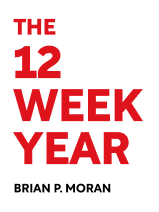

This article is an excerpt from the Shortform book guide to "The 12 Week Year" by Brian P. Moran. Shortform has the world's best summaries and analyses of books you should be reading.
Like this article? Sign up for a free trial here .
What is the 12 Week Plan? How does planning your annual execution cycle within the twelve-week timeframe help you increase productivity?
In The 12 Week Year, Brian Moran and Michael Lennington explain how to shorten your execution cycle from twelve months to twelve weeks. In the 12 Week Plan, a week takes the place of a month, and each day accounts for a week. Through this lens, you can see how important each day and week are, and your daily tasks take precedence over your long-term goals..
Learn how to implement the 12 Week Plan to fast-track your way to your goals.
A 12 Week Plan Versus a 12 Month Plan
A 12 Week Plan has several advantages over a year-long plan:
1. You increase predictability. You can’t possibly predict every action you’ll take over a 12-month period, so any plan made over this amount of time will be based on assumptions. Assumptions only allow you to guess at where you’ll be and what is possible at a certain point in your process. In contrast, a 12-week plan removes assumptions because the time frame is short enough for you to make accurate predictions of your future actions. After you set your vision for the future and break it into bite-sized behaviors that accumulate into the bigger picture, you will clearly see what tasks need to be accomplished first.
2. You increase focus. When you reduce your goal into bite-sized segments of action, you no longer have to manage multiple objectives at once. A year-long plan will include many different tasks that compose the overall goal, but too many objectives lead to confusion and inactivity because you’re trying to do too many things at once. When you train your focus on one or two actions at a time, you can tackle each task with a high degree of success. Each successful completion of your 12-week plan sets you up to build on that success in the next 12 weeks.
3. You develop a strong structure for your work. How you structure your plan determines your level of execution. Lengthy plans tend to involve too much theory and not enough practical application. In contrast, the aim of the 12 Week Plan is to create clear tactics for accomplishing your goals within three months. Tactics must be action-oriented and involve deadlines for each one. Within these time constraints, you’ll be able to follow your structured path toward your goal one action at a time with a sense of urgency.
Important Considerations of a Good Plan
Within the 12 Week Plan, a week now takes the place of a month, and each day accounts for a week. Through this lens, you can see how important each day and week are to your overall plan, and your daily activities become more important than your long-term objectives. Your plan of action for these activities should not be considered a glorified to-do list. Your plan should be an intentionally structured step-by-step process for how each day of work will lead to your weekly goal, which eventually leads to the completion of your overall 12-week goal.
You need to think of your plan like directions for a road trip. If you’re driving cross-country, missing turns, gaps in location, and misordered directions will get you lost every time. Likewise, a plan that skips necessary steps, overloads one task with too many objectives, and places actions in an unfavorable sequence will not lead you to your desired results.
Also, your plan needs to be actionable, not merely a set of ideas and wishes. Imagine a direction on your map that said, “Point the car west to get to California.” If you’re starting in Iowa, you’ll have no clear route to follow and will waste time guessing. Be specific in the actions needed to reach your goal.
Your plan can relate to either your short-term goals or long-term execution. Short-term goals might be a specific level of income, number of clients for your business, a certain weight, or new skill for your personal life. Long-term execution goals might be a college degree, larger staff, new operating system, or long life. With execution goals, your immediate efforts become focused on building a predetermined future state. Regardless of which type of plan it is, you must have a clear target you’re aiming for within the 12 weeks.
Your Plan Structure
First, you need a clear goal. Your 12 Week Plan might have more than one goal, but don’t overwhelm your efforts by trying to achieve too much too early. Remember, a 12-week plan is just one part of the process. You will continue to build more 12-week plans from the foundation created by the previous plan.
When you have a clear goal, list the various tasks that will help achieve that goal. At this point, list all that come to mind. You will refine the list later to only the most important ones, but you won’t know which they are if you don’t exhaust all the possibilities first.
Both your goals and tasks should follow these criteria:
1. Make them specific and measurable. You need to quantify and qualify your actions so you’ll be able to measure the success of your results.
2. Focus on the positive. Write your goals and tactics in a language that promotes wins, not avoids losses. Rather than “reduce error rate by 25%,” write, “Increase positive outcomes by 75%.”
3. Push yourself, but not too far. If your goal is too easy to reach, you’re not pushing your success enough. If it’s too hard, you’ll become frustrated.
4. Promote accountability. If you’re working alone, own your process. If you’re working as part of a team or leading a team, assign responsibility to individuals. Ownership promotes follow-through. This topic will be elaborated on in a later chapter.
5. Set deadlines. Set clear time parameters for when each goal and task should be achieved. This means detailing the day or week by which specific progress needs to be made.
Put Your Plan on Paper
You don’t need to figure everything out perfectly to begin writing your plan. Refer to your long- and short-term goals to get a good idea of what you need to accomplish without overanalyzing your strategy. You will check back in with your plan throughout the process using measures, and adjustments can be made at any time.
At the top of the page, write your first 12-week goal. Then, list the most significant action required to start the process, and specify which week this action will take place and the daily activities required within that week to achieve it. Continue with the rest of the tasks and weeks through 12.
You can bolster your chances of success by making a list of actions you anticipate experiencing difficulty with and how you will manage those difficulties. When you hit those snags, you’ll know what to do without panicking.
Taking the requisite time to plan may seem like a waste of time, but the time spent will save you time in the future. A solid plan of action can save 20% of the time normally required to complete a task without a clear path forward.
Steps for Creating Your First 12 Week Plan
You have received all of this information already, but having the steps reiterated will help you remember them in sequence and their significance.
Step 1: Create your compelling vision and connect emotionally with it.
Step 2: Set your first short-term (three-year) goal toward achieving that long-term vision.
Step 3: Determine the steps involved in reaching that short-term goal.
Step 4: Build a 12-week plan for accomplishing those steps.
Step 5: Build a model week for how you will achieve the necessary tasks.
Step 6: Use the first day of each week to measure your progress and plan the coming week.
Step 7: Follow through.
Steps 1 through 4 should happen before the 12 weeks begin. When you’re fully organized, that’s when you start your 12-week journey.
Your first four weeks will be all about building the habit of following your plan. Focus on the fundamentals of the 12-week year, and follow them to the letter. How you move through these first four weeks will determine the success of the other eight weeks to come. This month is when you want to hone your execution skills and manage your barriers.
The second four weeks will lack urgency, so staying motivated and committed is vital in the second month. Your routine is already established, and the ending is still a ways off. But at this point, you have some good measures of your lead and lag indicators and can use them to determine what’s working and what isn’t. These weeks are when you want to make significant adjustments to either your plan or execution so you can finish strong.
The last four weeks are when you start to see the results of your work. You may not be exactly where you want to be, but the fact that you’ve made it this far is a measure of success if you’ve been hitting a score of at least 85% a majority of the time. You’ve created new ways of thinking and approaching your work, and you have what you need to learn from this experience and increase your efforts for the next 12 weeks.
The 12 Week Year Weekly Plan Sample
Your weekly plans should be clear breakdowns of your overall 12-week plan. The tasks and benchmarks you aim for each week are mere elaborations of those listed on your main schedule of tasks. Don’t add new tasks to the weekly plans based on new interests or a sense of urgency. If you’re going to change the tasks for one week, change them on the main plan to keep the pacing of each priority action in order. In this way, you make sure each week is strategically organized to develop the main goal.
Just like in your 12-week plan, write each goal at the top of your new week, and list the specific actions that will happen daily throughout the week. Check in with this plan every morning and a few times throughout the day to make sure you’re staying on track and meeting your deadlines.
Example of Weekly Plan
| Week 4 Plan (Score: ___%) |
| Goal 1. Increase sales by 10%Step 1: Step 2:Step 3:Step 4: |
| Goal 2. Double number of clientsStep 1: Step 2:Step 3:Step 4: |
| Goal 3. Lose 15 poundsStep 1: Step 2:Step 3:Step 4: |
The 13th Week
Even if you didn’t hit your intended goal completely, chances are you made significant progress and have experienced some of the personal and professional benefits of your new system. The week after the 12-week plan ends can be used to finish up any loose ends to help reach the full goal. You can also use it as a period of reflection to assess your satisfaction with the process and your efforts. Finally, you should definitely use part of the 13th week to acknowledge your achievements, big or small, and celebrate.
If you’re in business, the 13th week is a good time for an action-review meeting to look over the separate efforts made by your employees that contributed to the overall goal. Use this review to begin planning your next 12 weeks using the information about what worked and what didn’t.
Whether in business or in your personal life, use the end of the 13th week to set a new goal for a brand new Week 1, and write your action plan. As you accumulate more 12-week periods of success, you’ll be surprised by how much you’ve accomplished and how close your vision is to becoming a reality. You can start living your full potential the moment you choose to implement this process. Don’t wait for the perfect time. Choose to be great now.

———End of Preview———
Like what you just read? Read the rest of the world's best book summary and analysis of Brian P. Moran's "The 12 Week Year" at Shortform .
Here's what you'll find in our full The 12 Week Year summary :
- How to create a structured plan to rapidly accomplish goals
- Why annual goals don't work
- How to create urgency by working in 12-week increments







Hello, I just search on google about Success & Goal achievement in 12 Weeks and got your post. I read and learn something. Thanks a lot.